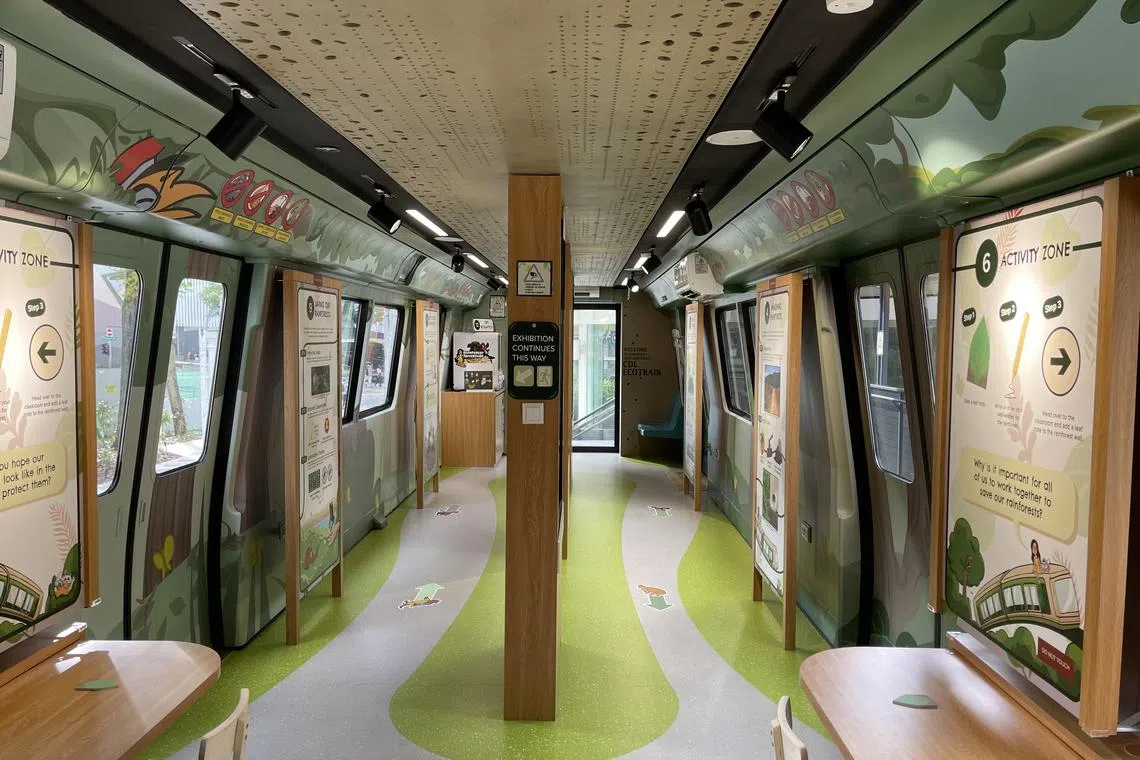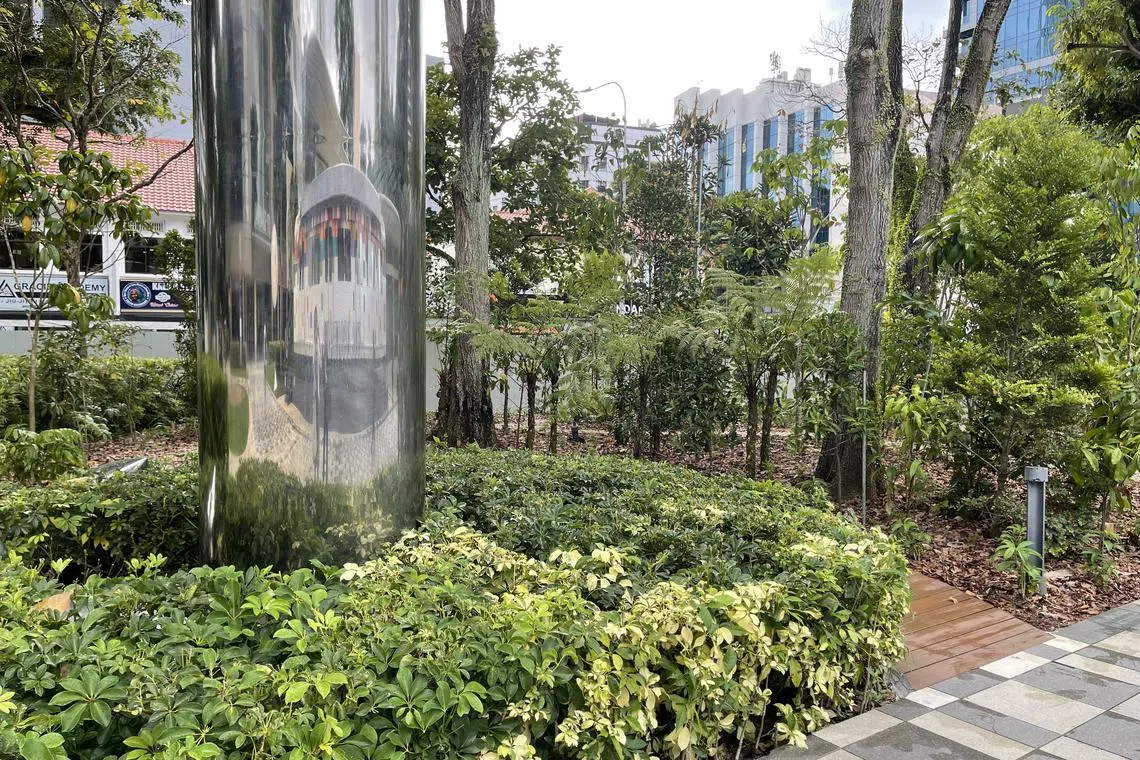CDL’s EcoTrain, MicroForest boost climate education efforts for the public
The decomissioned train cabin and a living flora exhibit aim to raise awareness of sustainablity and urban greening
[SINGAPORE] Just where you might least expect it, a “rainforest” has sprung up outside City Square Mall. And parked next to it is a train cabin.
It is City Developments Ltd’s (CDL) new EcoTrain, which opens to the public on Saturday (Mar 15). It aims to educate children and youth on different climate themes.
On entering the 30 m long colourful train cabin, visitors can walk through and learn about rainforests through informative panels on the wall, as well as interactive panels and workshops.
They will first come across a QR code on a screen, which they can scan to sign up and play an adventure quest-like game. This game has various stages and requires scanning a cat mascot called Qwerty around the train to answer questions and move on to the next stage.
All the information the users need to know are on the panels, which teach them about the different layers of the rainforest, biodiversity, ecosystem services, deforestation and more. In addition to the informative panels, there are also interactive panels, where users can play mini games or vote on which animal they feel is most threatened in the rainforest.
There is also an activity zone where users can write messages about nature or the rainforest.

CDL reached out to Kong Man Jing, also known by her online persona Biogirl MJ, as a programme partner for the EcoTrain.
Kong, founder of science and sustainability social media platform Just Keep Thinking, said: “The objective was to gamify learning so that it’s fun and exciting for kids.”
She added: “South-east Asian rainforests are often overlooked, so we wanted to put more spotlight on that. And we have forests in Singapore, but people don’t know about it. So we wanted to showcase the forest ecosystem in Singapore, and try to make it fun.”
On weekends, children and young people can sign up for free workshops conducted by Just Keep Thinking in a classroom setting at the back of the train.
Kong said: “Children can participate in activities like crafting with recycled materials, identifying native species and understanding the importance of conservation through interactive games.”
The last few panels in the EcoTrain focus on how people can contribute to conserving and saving the rainforest, by raising awareness or making sustainable choices. She added: “Education transforms abstract statistics into relatable stories, empowering the younger generation to recognise the impact of their choices.”
After completing all the stages, users receive a QR code, which they can scan on a gacha machine to receive an EcoTrain pin.
The EcoTrain was repurposed from a decommissioned SMRT train cabin. It has eco-friendly features, such as solar panels, rubber flooring and is built from low-carbon materials.
Esther An, chief sustainability officer of CDL, said the group decided to repurpose the old train cabin “for circularity and to reduce waste – otherwise all this metal will become waste”.
This is part of the Land Transport Authority’s upcycling initiative to repurpose decommissioned train cabins.
A forest in the heart of the city
In line with the EcoTrain’s rainforest theme, CDL also launched a regenerative tropical MicroForest outside City Square Mall.
Kong said: “This living exhibit showcases native flora, offering visitors a tangible connection to rainforest vegetation and the benefits of urban greening... It is a project that we can use to teach people the importance of innovative measures that are suited for Singapore’s landscape and climate.”
The MicroForest spans 2,800 square feet and was developed in collaboration with professors from the National University of Singapore, with input from the National Parks Board.
An said: “How can we use nature-based solutions to cool the temperature? When you cool the temperature, you reduce the use of energy and air conditioning, and that is how we decarbonise.”

CDL chose to build the MicroForest in an urban setting, so that it could have an impact in the city – where there is a lack of forests.
“If you build a forest in a faraway suburb – in our case, Mandai or Choa Chu Kang – it doesn’t help to cool urban spaces. So what we wanted to do is to bring the forest to urban spaces. We were lucky that in December 2024, City Square Mall was at the tail end of a major asset enhancement initiative,” she added.
The MicroForest was built within three months. Trees that contribute to biodiversity were conserved, and native species were planted. Native species are well-adapted to local climate conditions and help to maintain biodiversity.
“Within three months, we built the MicroForest because of how urgent the climate crisis is – we couldn’t wait,” An said.
Sensors to measure factors such as temperature and humidity were added to the MicroForest, as well as outside the EcoTrain. These compare the forest environment versus an urban setting, to observe the impact of the MicroForest. “This is a very research-driven initiative – not just for beauty or aesthetics. Once we have the data, we can scale up,” she added.
An hopes to one day see more MicroForests in both residential and commercial developments.
She said: “The most important thing is you plant it where it matters. It can create an impact on urban spaces. How do you bring it to the high-density city to improve thermal comfort, air quality and biodiversity?”
Decoding Asia newsletter: your guide to navigating Asia in a new global order. Sign up here to get Decoding Asia newsletter. Delivered to your inbox. Free.
Copyright SPH Media. All rights reserved.

